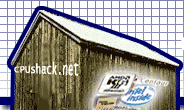


 |
 |
 |
| home | about | pictures | reference | trade | links |
SANTA CLARA, Calif., -- February 7, 1997– Intel Corporation today showcased in a technology demonstration a microprocessor based on Intel’s P6 architecture family at speeds of 400-MHz and higher at the International Solid State Circuits Conference (ISSCC) in San Francisco. The demonstration illustrated the performance potential of the P6 architecture and Intel’s existing high-volume manufacturing capabilities.
The superior performance headroom of the P6 processor family comes from the capability to deliver future advancements including higher clock speeds, a range of L2 cache configurations and enhancements like MMX™ media enhancement technology.
"With these advancements, users will continue to get enhanced performance for demanding software applications including visual, media-rich, communications, and technical applications for servers, workstations and desktops," said Mike Fister, vice president and general manager in Intel’s microprocessor products group. "Future P6 processors will also maintain the manageability features that have made the Pentium® Pro processor a great solution for business."
This 400-MHz processor technology demonstration has 7.5 million transistors and was produced on Intel’s current high-volume 0.35 micron manufacturing process technology. This is the exact same process that Intel uses today to produce the overwhelming majority of its microprocessor product line.
Intel, the world's largest chip maker, is also a leading manufacturer of personal computer, networking, and communications products. Through innovative technologies, Intel is committed to improving the Internet experience for PC consumers. Additional information is available at www.intel.com.